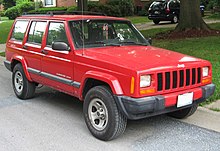
Back Sportnutsvoertuig Afrikaans سيارة رياضية متعددة الأغراض Arabic SUV Azerbaijani Автомобил с повишена проходимост Bulgarian Mubil SUV BJN এসইউভি Bengali/Bangla Vehicle esportiu utilitari Catalan SUV Czech SUV Danish Sport Utility Vehicle German
This article has multiple issues. Please help improve it or discuss these issues on the talk page. (Learn how and when to remove these messages)
|
A sport utility vehicle (SUV) is a car classification that combines elements of road-going passenger cars with features from off-road vehicles, such as raised ground clearance and four-wheel drive.
There is no commonly agreed-upon definition of an SUV, and usage of the term varies between countries. Thus, it is "a loose term that traditionally covers a broad range of vehicles with four-wheel drive."[1] Some definitions claim that an SUV must be built on a light truck chassis; however, broader definitions consider any vehicle with off-road design features to be an SUV. A crossover SUV is often defined as an SUV built with a unibody construction (as with passenger cars); however, the designations are increasingly blurred because of the capabilities of the vehicles, the labelling by marketers, and the electrification of new models.[2]
The predecessors to SUVs date back to military and low-volume models from the late 1930s, and the four-wheel-drive station wagons and carryalls that began to be introduced in 1949. Some SUVs produced today use unibody construction; however, in the past, more SUVs used body-on-frame construction. During the late 1990s and early 2000s, the popularity of SUVs significantly increased, often at the expense of the popularity of large sedans and station wagons. SUVs accounted for 45.9% of the world's passenger car market in 2021.[3]
SUVs have been criticized for a variety of environmental and safety-related reasons. They generally have poorer fuel efficiency and require more resources to manufacture than smaller vehicles, contributing more to climate change and environmental degradation.[4] Between 2010 and 2018, SUVs were the second-largest contributor to the global increase in carbon emissions worldwide.[5] Their higher center of gravity increases their risk of rollovers. Their higher front-end profile makes them at least twice as likely to kill pedestrians they hit.[6][7][8] Additionally, the psychological sense of security they provide influences drivers to drive less cautiously.[9]
- ^ "SUV Meaning: What is an SUV?". Car and Driver. 13 April 2020. Retrieved 30 August 2022.
- ^ Wardlaw, Christian (15 September 2021). "What is a Crossover SUV?". J.D. Power. Retrieved 30 August 2022.
- ^ "New registrations of SUVs in key car markets, 2010-2021 – Charts – Data & Statistics". iea.org. 21 December 2021. Retrieved 1 October 2024.
- ^ Cite error: The named reference
InternationalEnergywas invoked but never defined (see the help page). - ^ Kommenda, Niko (25 October 2019). "SUVs second biggest cause of emissions rise, figures reveal". The Guardian. Retrieved 1 October 2024.
- ^ Rose, Joel (14 November 2023). "Taller cars and trucks are more dangerous for pedestrians, according to crash data". npr.org. Retrieved 1 October 2024.
- ^ Tyndall, Justin (March 2024). "The effect of front-end vehicle height on pedestrian death risk". Economics of Transportation. 37. doi:10.1016/j.ecotra.2024.100342. Retrieved 1 October 2024.
- ^ Lawrence, Eric D.; Bomey, Nathan; Tanner, Kristi (1 July 2018). "Death on foot: America's love of SUVs is killing pedestrians". Detroit Free Press. Archived from the original on 14 December 2019. Retrieved 24 December 2019.
- ^ Gladwell, Malcolm (4 January 2004). "Big and Bad". The New Yorker. Archived from the original on 19 February 2016. Retrieved 1 October 2024.


